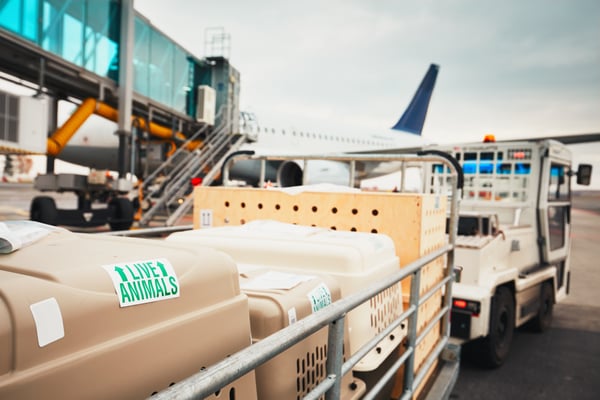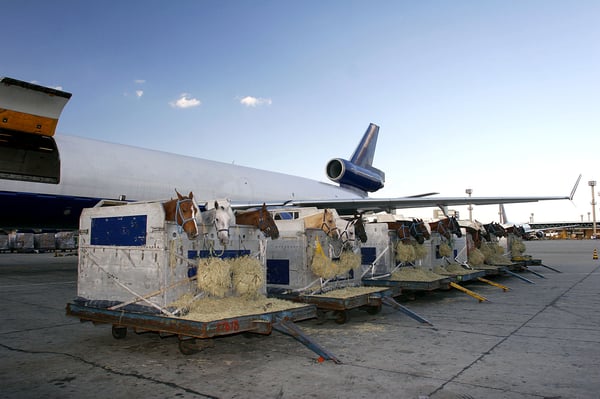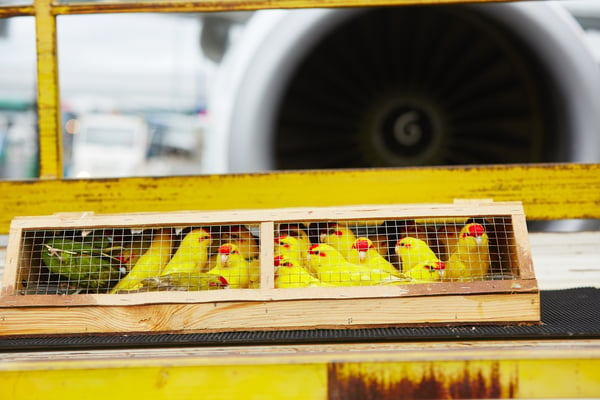To reduce stress on animals that need transportation, it is vital that journeys times are kept as short as possible.
Therefore transport by air is the only viable transport option over long distances.
However, there are a number of challenges involved in transporting live animals, and there are a number of guidelines given by IATA to mitigate any discomfort and stress for the animals.
(The International Air Transport Association (IATA) is not a regulatory body, but airline members of the Association are obliged to follow IATA’s Live Animals Regulations)

Because air transport is the best way of transporting live animals on long journeys, it is important to ensure high standards are maintained by all those who are involved in the care of the livestock
Key factors
The key factors that affect the safe transport of live animals include the:
- Aircraft Environmental Control System (ECS) settings
- Animal physical needs and functions
- Airport and en-route environments
- Ground handling and processing
Each animal species require different considerations regarding ECS settings, handling, packing and loading configurations. If different species are being transported together this will complicate the management of these key factors.
It is imperative that ECS systems can keep the cargo compartments at optimum temperatures at all times. This is particularly challenging during ground operations when external ambient temperatures are high and strong sunlight can heat the aircraft while stationary, resulting high temperatures in the cargo compartments.

Environmental Factors
The safe transportation of live animals as air cargo is based on controlling three environmental factors:
- Temperature
- Relative humidity levels
- Carbon dioxide concentrations
Each type of animal has unique environmental requirements for optimum health. Failure to adequately control these environmental factors may have an impact on animal wellbeing, comfort, and survivability.
Guidelines
Guidelines that can help operators optimise animal welfare and maximise animal cargo customer satisfaction.
- Prepare the cargo compartment environment before loading the animals. If possible, use the aircraft ECS system to get the cargo hold to the right temperature and humidity level before loading.
- Minimise the time the airplane spends on the ground, including during stopovers, while animals are onboard.
- Load animals as near to the departure time as possible.
- Unload animals immediately upon arrival at the destination. Ensure that ground crew personnel are available and ready to unload the animals as soon as the airplane lands.
- Close the cargo doors last before departure and open cargo doors first upon arrival. Adequate ventilation helps control carbon dioxide and humidity levels that would otherwise build up in the cargo compartment.
- Avoid holding animals in the airplane in the sun. Where at all possible load live animal cargo at night to avoid high temperatures and the aircraft's exposure to solar energy from the sun.
- Do not transport animals and carbon dioxide (including dry ice) in the same cargo compartment.
- Avoid carriage of live animals with cargo that contain a lot of moisture such as perishables, refrigerated products that will condensate, flowers and frozen products.
- To control high humidity and contain liquid spillages, use suitable absorbent sheeting to line the animal cages and underneath any accompanying cargo that may sweat or condensate in transit.

Points to consider
When animals are being transported over long distances, and travel from one climate zone to another, it is important that care should be taken to plan the journey so that animals do not experience a sudden change in climate at their destination, unless a controlled environment is available on arrival that will avoid any stress for the animals.
Considerable distress can be caused to animals due to extended transit stops at airports. It is important that, when these stops do occur, proper arrangements are made in advance to ensure that the animals are not subject to extremes of temperature. On aircraft, the heating and air conditioning systems are usually shut down on extended transit stops, and arrangements should be made, for the animals to be unloaded and held in more suitable conditions until the journey is resumed, or for means of cooling to be brought into service in the cargo hold during the stopover.
It is important to consider whether any preparation should be made before travelling for any required quarantine measures or other animal health regulations at the airports of intermediate stops or at the final destination.
Animal consignments should be collected promptly at their final destination. If there is an unexpected delay, obtain the help of a veterinary professional, a local animal welfare organisation, or a person experienced in the care and handling of the animals. If live animals have to be left for extended periods in airports they should be housed in places where unauthorised persons do not have any access.
Animals shipped in crates should be kept away from direct exposure to the sun and extremes of temperature.

Some species of animals are more susceptible to stress than others. These guidelines will help to ensure that animals are successfully transported around the globe, minimising stress, and protecting the aircraft from damage due to high moisture levels and stressed livestock.


